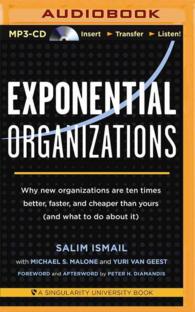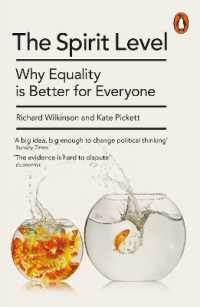- ホーム
- > 洋書
- > 英文書
- > Politics / International Relations
基本説明
New in paperback. Hardcover was published in 2006. Explains how the Senate managed to satisfy its lawmaking role during the nineteenth and early twentieth century, when it lacked seemingly essential formal rules for governing debate.
Full Description
Parliamentary obstruction, popularly known as the "filibuster," has been a defining feature of the U.S. Senate throughout its history. In this book, Gregory J. Wawro and Eric Schickler explain how the Senate managed to satisfy its lawmaking role during the nineteenth and early twentieth century, when it lacked seemingly essential formal rules for governing debate. What prevented the Senate from self-destructing during this time? The authors argue that in a system where filibusters played out as wars of attrition, the threat of rule changes prevented the institution from devolving into parliamentary chaos. They show that institutional patterns of behavior induced by inherited rules did not render Senate rules immune from fundamental changes. The authors' theoretical arguments are supported through a combination of extensive quantitative and case-study analysis, which spans a broad swath of history. They consider how changes in the larger institutional and political context--such as the expansion of the country and the move to direct election of senators--led to changes in the Senate regarding debate rules.
They further investigate the impact these changes had on the functioning of the Senate. The book concludes with a discussion relating battles over obstruction in the Senate's past to recent conflicts over judicial nominations.
Contents
*FrontMatter, pg. i*Contents, pg. v*List of Tables, pg. vii*List of Figures, pg. ix*Preface, pg. xi*Chapter 1. Introduction, pg. 1*Chapter 2. Obstruction in Theoretical Context, pg. 25*Chapter 3. The Mutability of Senate Rules, pg. 61*Chapter 4. Where's the Pivot?, pg. 89*Chapter 5. Dilatory Motions and the Success of Obstruction, pg. 109*Chapter 6. Obstruction and the Tariff, pg. 127*Chapter 7. Slavery and Obstruction in the Antebellum Senate, pg. 159*Chapter 8. Obstruction and Institutional Change, pg. 181*Chapter 9. Cloture Reform Reconsidered, pg. 211*Chapter 10. The Impact of Cloture on the Appropriations Process, pg. 237*Chapter 11. Conclusion, pg. 259*Bibliography, pg. 285*Index, pg. 303








